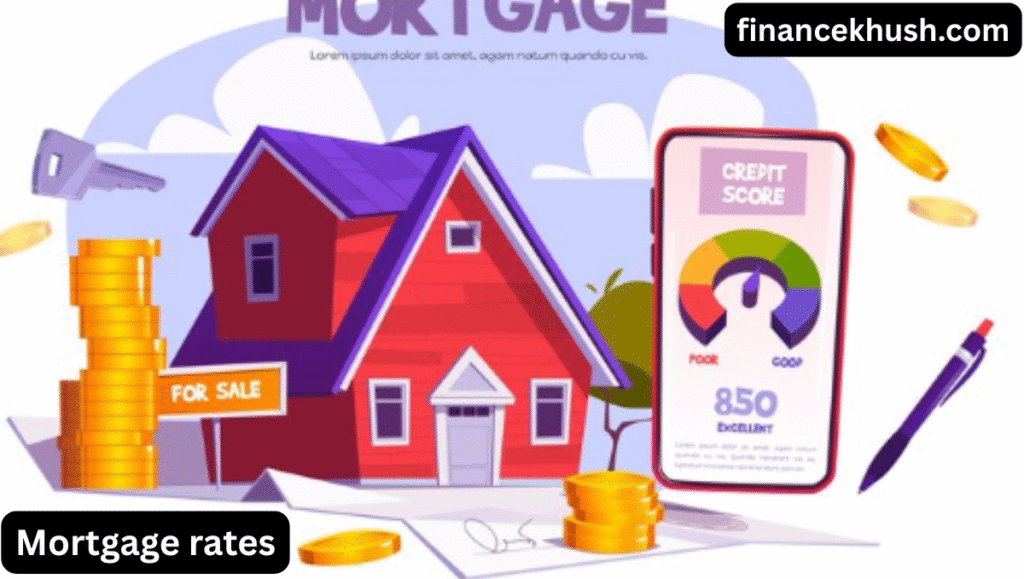Buying a home is one of the most significant financial decisions most people will ever make. Among the many factors to consider when purchasing a home, mortgage rates play a central role in determining how much you’ll end up paying over the life of your loan. In this guide, we’ll walk you through everything you need to know about mortgage rates, including what they are, how they work, and what influences them.
What Are Mortgage Rates?
Mortgage rates are the interest rates charged by lenders on home loans. When you take out a mortgage to buy a home, the lender provides you with the funds, and in return, you agree to pay back the loan with interest over a set period of time. The mortgage rate is the cost of borrowing that money.
These rates are typically expressed as an annual percentage rate (APR), which represents the total yearly cost of borrowing, including interest and other fees. For most homeowners, the mortgage rate is the biggest factor in determining how much they will pay each month and how much interest they’ll pay over the life of the loan.
How Do Mortgage Rates Work?
A mortgage rate is the percentage of the loan amount that a lender charges you to borrow the money. It can either be fixed or adjustable.
- Fixed-Rate Mortgages: With a fixed-rate mortgage, the interest rate remains the same for the entire term of the loan. This provides stability, as your monthly payment will never change, regardless of what happens with interest rates in the broader economy.
- Adjustable-Rate Mortgages (ARMs): With an ARM, the interest rate is tied to an underlying benchmark or index, which can fluctuate over time. Typically, ARMs have an initial period with a fixed rate for a few years, after which the rate adjusts periodically, based on changes in the market.
Types of Mortgage Rates
Mortgage rates come in various forms, with each having its advantages and disadvantages. The two most common types are:
1. Fixed-Rate Mortgages
A fixed-rate mortgage has an interest rate that stays the same for the entire loan term, which typically ranges from 15 to 30 years. The main advantage of a fixed-rate mortgage is predictability. Your monthly payment remains consistent, which can help you budget more effectively over the life of the loan.
Pros of Fixed-Rate Mortgages:
- Predictable monthly payments.
- Protection from interest rate fluctuations.
- Ideal for long-term homeowners who plan to stay in the property for many years.
Cons of Fixed-Rate Mortgages:
- Higher initial interest rates compared to ARMs.
- Less flexibility if interest rates decrease after the loan is taken out.
2. Adjustable-Rate Mortgages (ARMs)
An ARM typically offers a lower initial interest rate for a fixed period (e.g., 5, 7, or 10 years), after which the rate can adjust periodically. This type of mortgage is ideal for homeowners who plan to move or refinance before the adjustment period kicks in. However, ARMs come with the risk of rising interest rates, leading to higher monthly payments.

Pros of ARMs:
- Lower initial rates and payments.
- Potential savings if interest rates stay low or decrease.
- Good for buyers who expect to move or refinance within a few years.
Cons of ARMs:
- Interest rates can increase over time.
- Uncertainty in monthly payments after the initial fixed period.
What Factors Influence Mortgage Rates?
Mortgage rates are not static; they change frequently based on several factors. Some of the most important ones include:
1. The Federal Reserve (Fed) and Economic Conditions
The Federal Reserve’s actions have a major influence on mortgage rates. The Fed adjusts short-term interest rates to control inflation and stabilize the economy. When the Fed raises rates, borrowing costs for consumers rise, including mortgage rates. Conversely, when the Fed lowers rates, mortgage rates tend to decrease as well.
Economic conditions also play a significant role. In times of economic growth, demand for housing typically increases, which can push mortgage rates higher. Conversely, during economic downturns, rates tend to decrease as the central bank takes steps to stimulate growth.
2. Inflation
Inflation refers to the rate at which the general level of prices for goods and services rises. When inflation is high, lenders often raise mortgage rates to maintain their profits. High inflation means that money will be worth less in the future, so lenders need to charge higher rates to compensate for that risk.
3. The Bond Market
Mortgage rates are closely tied to the performance of the bond market, particularly the 10-year U.S. Treasury bond. When bond prices rise, mortgage rates tend to fall, and vice versa. Investors buy and sell these bonds based on their expectations of the economy, and their actions can impact mortgage rates.
4. Lender Competition
Different lenders may offer slightly different rates depending on the competition in the market. If one lender lowers their rates, other lenders may follow suit in an attempt to attract more customers. Shopping around and comparing mortgage rates is essential for finding the best deal.
5. Credit Score and Down Payment
Your individual financial profile also affects the mortgage rate you receive. A higher credit score indicates to lenders that you are less of a risk, which can lead to a lower interest rate. Similarly, a larger down payment reduces the lender’s risk and may result in a more favorable mortgage rate.
6. Loan Term
The length of your loan term (i.e., how many years you have to repay the mortgage) also influences the rate. Shorter-term loans, such as 15-year mortgages, generally come with lower interest rates compared to longer-term loans, such as 30-year mortgages.
How to Find the Best Mortgage Rate
Finding the best mortgage rate for your situation involves more than just checking the rate on a lender’s website. Here are some tips for getting the best deal:
1. Shop Around
Mortgage rates can vary significantly between lenders, so it’s essential to shop around. Compare rates from multiple banks, credit unions, and online lenders. Don’t just look at the interest rate; consider the APR, which includes additional fees like closing costs.
2. Consider Your Loan Type
The loan type you choose—whether it’s a fixed-rate or adjustable-rate mortgage—can significantly impact your rate. Fixed-rate mortgages tend to have higher rates upfront, but they offer more stability. If you plan to stay in the home for a long time, a fixed-rate mortgage might be your best bet.
3. Improve Your Credit Score
Lenders often offer better rates to borrowers with higher credit scores. If you have time before applying for a mortgage, try to improve your credit score by paying down debts, correcting errors on your credit report, and avoiding new credit inquiries.
4. Save for a Larger Down Payment
The more money you put down upfront, the less risky you are to lenders. This can help you secure a lower mortgage rate. A down payment of at least 20% can help you avoid paying private mortgage insurance (PMI), which adds to your monthly payment.
5. Consider Points
Some lenders offer the option to pay “points” to lower your mortgage rate. A point is typically equal to 1% of your loan amount, and paying it upfront can reduce your rate. This can be a good option if you plan to stay in the home long enough to recoup the upfront cost.
How Mortgage Rates Affect Your Monthly Payment
Your mortgage rate directly impacts how much you’ll pay every month. Even a small difference in your interest rate can result in significant savings (or higher costs) over time. Here’s an example to illustrate:
Let’s say you are borrowing $300,000 on a 30-year fixed-rate mortgage:
- At a 3.0% interest rate, your monthly payment would be approximately $1,264.
- At a 4.0% interest rate, your monthly payment would be approximately $1,432.
- At a 5.0% interest rate, your monthly payment would be approximately $1,610.
As you can see, a higher mortgage rate results in a larger monthly payment, which can significantly impact your budget.

The Long-Term Impact of Mortgage Rates
While your mortgage rate is essential for determining your monthly payment, it also affects the total cost of the home over the life of the loan. Here’s a breakdown of how much you might pay over 30 years at different interest rates:
- 3.0% interest rate: You’ll pay about $155,000 in interest over the life of the loan.
- 4.0% interest rate: You’ll pay about $215,000 in interest.
- 5.0% interest rate: You’ll pay about $274,000 in interest.
As you can see, the higher your mortgage rate, the more you’ll pay in interest over time.
Conclusion
Mortgage rates are a key factor when buying a home, and understanding how they work can save you a significant amount of money. By shopping around for the best rates, improving your credit score, and considering the type of mortgage that best fits your financial situation, you can lock in a rate that helps make homeownership more affordable.
related post
- https://financekhush.com/how-capital-gains-tax-works-in-2025/
- https://financekhush.com/mobile-banking-a-comprehensive-guide-2025/
Faq’s
1. What is a mortgage rate?
A mortgage rate is the interest rate a lender charges you when you borrow money to buy a home. It’s the cost of borrowing that money and is added to your loan repayment each month.
2. What’s the difference between a fixed-rate mortgage and an adjustable-rate mortgage?
- Fixed-rate mortgage: The interest rate stays the same for the entire loan term (e.g., 15 or 30 years). Your payments are predictable and won’t change.
- Adjustable-rate mortgage (ARM): The interest rate changes after an initial period (like 5, 7, or 10 years). Your payments could go up or down over time.
3. What factors affect mortgage rates?
Mortgage rates can change based on:
- The economy (e.g., inflation, the Federal Reserve’s decisions).
- Your credit score (better score = better rate).
- The size of your down payment (larger down payment = lower rate).
- The loan term (shorter loans usually have lower rates).
4. How do I find the best mortgage rate?
To get the best rate, you should:
- Compare lenders to see which offers the lowest rate.
- Improve your credit score before applying.
- Save for a bigger down payment to lower your interest rate.
5. Why do mortgage rates change?
Mortgage rates change because of shifts in the economy and interest rates set by the Federal Reserve. They can also change based on market conditions, like bond prices or inflation.https://financeforu.com/
6. How does my mortgage rate affect my monthly payment?
A higher mortgage rate means a higher monthly payment. Even a small change in the rate can make a big difference in how much you pay each month and how much interest you pay over the life of the loan.

1 thought on “How Mortgage Rates Impact Your Home Loan: A Simple Guide 2025”